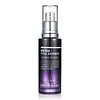What's inside
What's inside
 Key Ingredients
Key Ingredients

 Benefits
Benefits

 Ingredients Side-by-side
Ingredients Side-by-side

Water
Skin ConditioningButylene Glycol
HumectantLactobacillus/Pumpkin Ferment Extract
Skin ConditioningBifida Ferment Lysate
Skin ConditioningNiacinamide
SmoothingMethyl Gluceth-20
HumectantGlycerin
HumectantPhenoxyethanol
Preservative1,2-Hexanediol
Skin ConditioningSodium Hyaluronate
HumectantCaprylhydroxamic Acid
Aureobasidium Pullulans Ferment
Skin ConditioningAdenosine
Skin ConditioningBoswellia Serrata Resin Extract
SmoothingCamellia Sinensis Leaf Extract
AntimicrobialPanax Ginseng Root Extract
EmollientSodium Polyacrylate
AbsorbentCopper Tripeptide-1
Skin ConditioningEthylhexylglycerin
Skin ConditioningAcetyl Hexapeptide-8
HumectantWater, Butylene Glycol, Lactobacillus/Pumpkin Ferment Extract, Bifida Ferment Lysate, Niacinamide, Methyl Gluceth-20, Glycerin, Phenoxyethanol, 1,2-Hexanediol, Sodium Hyaluronate, Caprylhydroxamic Acid, Aureobasidium Pullulans Ferment, Adenosine, Boswellia Serrata Resin Extract, Camellia Sinensis Leaf Extract, Panax Ginseng Root Extract, Sodium Polyacrylate, Copper Tripeptide-1, Ethylhexylglycerin, Acetyl Hexapeptide-8
Camellia Sinensis Extract
AntioxidantPropanediol
SolventGlycerin
Humectant2,3-Butanediol
HumectantTrehalose
HumectantWater
Skin ConditioningBetaine
Humectant1,2-Hexanediol
Skin ConditioningStreptococcus Thermophilus Ferment
HumectantChlorella Vulgaris Extract
Skin ConditioningTheobroma Cacao Extract
Skin ConditioningPyrus Malus Juice
Skin ConditioningSodium Hyaluronate
HumectantOryza Sativa Extract
AbsorbentAlthaea Rosea Extract
EmollientHydrolyzed Hyaluronic Acid
HumectantHyaluronic Acid
HumectantCentella Asiatica Extract
CleansingTremella Fuciformis Extract
HumectantArtemisia Princeps Extract
Skin ConditioningHouttuynia Cordata Extract
Skin ConditioningSaururus Chinensis Leaf/Root Extract
AntimicrobialAgave Tequilana Leaf Extract
AstringentButylene Glycol
HumectantPanthenol
Skin ConditioningGlucose
HumectantPPG-13-Decyltetradeceth-24
EmulsifyingFructooligosaccharides
HumectantFructose
HumectantAdenosine
Skin ConditioningDextrin
AbsorbentEthylhexylglycerin
Skin ConditioningGlyceryl Acrylate/Acrylic Acid Copolymer
HumectantTromethamine
BufferingHydroxypropyltrimonium Hyaluronate
Sodium Acetylated Hyaluronate
HumectantTocopherol
AntioxidantHydrolyzed Sodium Hyaluronate
Skin ConditioningSodium Hyaluronate Crosspolymer
HumectantPotassium Hyaluronate
Skin ConditioningDisodium EDTA
Carbomer
Emulsion StabilisingCamellia Sinensis Extract, Propanediol, Glycerin, 2,3-Butanediol, Trehalose, Water, Betaine, 1,2-Hexanediol, Streptococcus Thermophilus Ferment, Chlorella Vulgaris Extract, Theobroma Cacao Extract, Pyrus Malus Juice, Sodium Hyaluronate, Oryza Sativa Extract, Althaea Rosea Extract, Hydrolyzed Hyaluronic Acid, Hyaluronic Acid, Centella Asiatica Extract, Tremella Fuciformis Extract, Artemisia Princeps Extract, Houttuynia Cordata Extract, Saururus Chinensis Leaf/Root Extract, Agave Tequilana Leaf Extract, Butylene Glycol, Panthenol, Glucose, PPG-13-Decyltetradeceth-24, Fructooligosaccharides, Fructose, Adenosine, Dextrin, Ethylhexylglycerin, Glyceryl Acrylate/Acrylic Acid Copolymer, Tromethamine, Hydroxypropyltrimonium Hyaluronate, Sodium Acetylated Hyaluronate, Tocopherol, Hydrolyzed Sodium Hyaluronate, Sodium Hyaluronate Crosspolymer, Potassium Hyaluronate, Disodium EDTA, Carbomer
Ingredients Explained
These ingredients are found in both products.
Ingredients higher up in an ingredient list are typically present in a larger amount.
1,2-Hexanediol is a synthetic liquid and another multi-functional powerhouse.
It is a:
- Humectant, drawing moisture into the skin
- Emollient, helping to soften skin
- Solvent, dispersing and stabilizing formulas
- Preservative booster, enhancing the antimicrobial activity of other preservatives
Adenosine is in every living organism. It is one of four components in nucleic acids that helps store our DNA.
Adenosine has many benefits when used. These benefits include hydrating the skin, smoothing skin, and reducing wrinkles. Once applied, adenosine increases collagen production. It also helps with improving firmness and tissue repair.
Studies have found adenosine may also help with wound healing.
In skincare products, Adenosine is usually derived from yeast.
Learn more about AdenosineButylene Glycol (or BG) is used within cosmetic products for a few different reasons:
Overall, Butylene Glycol is a safe and well-rounded ingredient that works well with other ingredients.
Though this ingredient works well with most skin types, some people with sensitive skin may experience a reaction such as allergic rashes, closed comedones, or itchiness.
Learn more about Butylene GlycolEthylhexylglycerin (we can't pronounce this either) is commonly used as a preservative and skin softener. It is derived from glyceryl.
You might see Ethylhexylglycerin often paired with other preservatives such as phenoxyethanol. Ethylhexylglycerin has been found to increase the effectiveness of these other preservatives.
Glycerin is already naturally found in your skin. It helps moisturize and protect your skin.
A study from 2016 found glycerin to be more effective as a humectant than AHAs and hyaluronic acid.
As a humectant, it helps the skin stay hydrated by pulling moisture to your skin. The low molecular weight of glycerin allows it to pull moisture into the deeper layers of your skin.
Hydrated skin improves your skin barrier; Your skin barrier helps protect against irritants and bacteria.
Glycerin has also been found to have antimicrobial and antiviral properties. Due to these properties, glycerin is often used in wound and burn treatments.
In cosmetics, glycerin is usually derived from plants such as soybean or palm. However, it can also be sourced from animals, such as tallow or animal fat.
This ingredient is organic, colorless, odorless, and non-toxic.
Glycerin is the name for this ingredient in American English. British English uses Glycerol/Glycerine.
Learn more about GlycerinSodium Hyaluronate is hyaluronic acid's salt form. It is commonly derived from the sodium salt of hyaluronic acid.
Like hyaluronic acid, it is great at holding water and acts as a humectant. This makes it a great skin hydrating ingredient.
Sodium Hyaluronate is naturally occurring in our bodies and is mostly found in eye fluid and joints.
These are some other common types of Hyaluronic Acid:
Learn more about Sodium HyaluronateWater. It's the most common cosmetic ingredient of all. You'll usually see it at the top of ingredient lists, meaning that it makes up the largest part of the product.
So why is it so popular? Water most often acts as a solvent - this means that it helps dissolve other ingredients into the formulation.
You'll also recognize water as that liquid we all need to stay alive. If you see this, drink a glass of water. Stay hydrated!
Learn more about Water